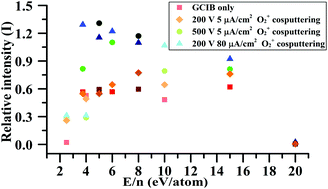Effect of energy per atom (E/n) on the Ar gas cluster ion beam (Ar-GCIB) and O2+ cosputter process†
Abstract
Gas cluster ion beam (GCIB) is a promising technique for preserving molecular structures during ion sputtering and successfully profiling biological and soft materials. However, although GCIB yields lower damage accumulation compared with C60+ and monoatomic ion beams, the inevitable alteration of the chemical structure can introduce artifacts into the resulting depth profile. To enhance the ionization yield and further mask damage, a low-energy O2+ (200–500 V) cosputter can be applied. While the energy per atom (E/n) of GCIB is known to be an important factor influencing the sputter process, the manner through which E/n affects the GCIB-O2+ cosputter process remains unclear. In this study, poly(ethylene terephthalate) (PET) was used as a model material to investigate the sputter process of 10–20 kV Ar1000–4000+ (E/n = 2.5–20 eV per atom) with and without O2+ cosputter at different energies and currents. Time-of-flight secondary ion mass spectrometry (ToF-SIMS) with Bi32+ as the primary ion was used to examine surfaces sputtered at different fluences. The sputter craters were also measured by alpha-step and atomic force microscopy in quantitative imaging mode. The SIMS results showed that the steady-state cannot be obtained with E/n values of less than 5 eV per atom due to damage accumulation using single GCIB sputtering. With a moderate E/n value of 5–15 eV per atom, the steady-state can be obtained, but the ∼50% decay in intensity indicated that damage cannot be masked completely despite the higher sputter yield. Furthermore, the surface Young's modulus decreased with increasing E/n, suggesting that depolymerization occurred. At an E/n value of 20 eV per atom, a failed profile was obtained with rapidly decreased sputter rate and secondary ion intensity due to the ion-induced crosslink. With O2+ cosputtering and a moderate E/n value, the oxidized species generated by O2+ enhanced the ionization yield, which led to a higher ion intensity at steady-state in general. Because higher kinetic energy or current density of O2+ led to a larger interaction volume and more structural damage that suppressed molecular ion intensity, the enhancement from O2+ was most apparent with low-energy–high-current (200 V, 80 μA cm−2) or high-energy–low-current (500 V, 5 μA cm−2) O2+ cosputtering with 0.5 μA cm−2 GCIBs. In these cases, little or no intensity drop was observed at the steady-state.



 Please wait while we load your content...
Please wait while we load your content...